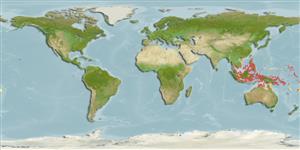Common names from other countries
>
Kurtiformes (Nurseryfishes, cardinalfishes.) >
Apogonidae (Cardinalfishes) > Apogoninae
Etymology: nanus: Name from Latin 'nanus' meaning dwarf, referring to its size being one of the smallest in the genus..
More on authors: Allen, Kuiter & Randall.
Environment: milieu / climate zone / depth range / distribution range
Ecologie
marien rifbewoner; diepte 3 - 20 m (Ref. 48635). Tropical
Western Central Pacific: Madang, Papua New Guinea; Maumere, Indonesia; and, near Kota Kinabalu, Sabah, Malaysia.
Grootte / Gewicht / Leeftijd
Maturity: Lm ? range ? - ? cm
Max length : 6.0 cm SL mannelijk / geslacht onbekend; (Ref. 48635)
Korte beschrijving
Determinatiesleutels | Morfologie | Morfometrie
Dorsale stekels (totaal) : 7; Dorsale zachte stralen (totaal) : 9; Anale stekels: 2; Anale zachte stralen: 8; Wervels: 24. This species is distinguished by having D VI-I,9; A II,8; pectoral rays 13; lateral line scales 24; predorsal scales 5; gill rakers 7 or 8+20 or 21, excluding an indistinct rudiment on upper limb; preopercular margin serrate; preopercular ridge smooth; body depth 3.4-3.7 in SL; semi-transparent in life with golden-brown midlateral strip, bordered below by narrow silver stripe; tip of lower jaw blackish (Ref. 11893).
Occurs in silty inshore reefs; aggregations observed hovering during the day around both soft and hard coral formations. An oral brooding male collected at Madang, papua New Guinea, contained 328 eggs, which is a relatively low number for the genus (Ref. 11893).
Levenscyclus en paargedrag
Maturities | Voortplanting | Spawnings | Egg(s) | Fecundities | Larven
Mouthbrooders (Ref. 240). Distinct pairing during courtship and spawning (Ref. 205).
Allen, G.R., R.H. Kuiter and J.E. Randall, 1994. Descriptions of five new species of cardinalfishes (Apogonidae: Apogon) from Maumere Bay, Flores, Indonesia and surrounding regions. Rev. Fr. Aquariol. 21(1-2):27-38. (Ref. 11893)
Status op de Rode Lijst van het IUCN (Ref. 130435)
CITES (Ref. 128078)
Not Evaluated
Gevaar voor de mens
Harmless
Gebruik door de mens
Tools
Can't connect to MySQL database fbquizv2. Errorcode: Too many connections
